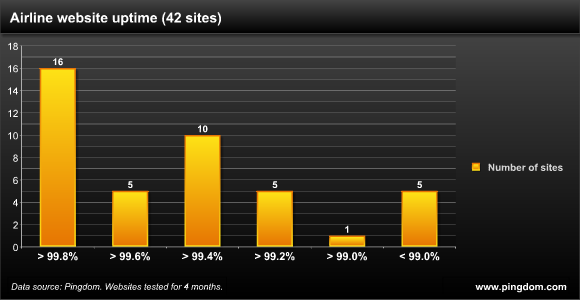 Last week we published a report about website uptime for airlines.
Last week we published a report about website uptime for airlines.
We had monitored the uptime of 42 international airline websites during a period of four months. The results were quite surprising so we figured we would share some of our findings here as well.
The full report is available as a free PDF, but below is a brief summary of the main points.
Key findings
Here are some of the discoveries we made:
- Below average uptime. The average uptime for the entire group of 42 websites was 99.49%. Over a year, a 99.49% uptime is the equivalent of more than 44 hours of downtime. This is worse than the average for websites on the Internet which hovers around 99.6%, the equivalent of 35 hours of downtime in a year.
- The most reliable. Only 13 out of the 42 tested websites (31%) had a 99.9% uptime or better: KLM (99.99%), United (99.98%), Japan Airlines (99.98%), Frontier (99.98%), Virgin Blue (99.96%), Open Skies (99.95%), Skynet Asia (99.95%), British Airways (99.94%), ANA Sky (99.94%), Air France (99.93%), NWA (99.92%), Eva Air (99.92%), Southwest (99.91%). American Airlines was close to enter this list, with 99.89% uptime.
- The unreliable. 26 out of 42 (62%) had less than 99.8% uptime, which is what we consider the minimum acceptable limit for such important websites. In this sense, 62% of the airline websites failed this test.
- The ones with the most problems. 5 out of the 42 websites (12%) had less than a 99.0% uptime. That is the equivalent of more than 3 days and 15 hours of downtime in a year. These sites were JetBlue, Cayman Airways, SAS, Korean Air and Egyptair.
- The pattern. Among the websites that ended up below a 99.8% uptime, frequent short outages were the most common problem.
We consider 99.8% to be the minimum required uptime for websites this important. We know that this is achievable by professional websites run by companies with far less resources than airlines.
A 99.8% uptime means that a website can be unavailable for a total of 17 hours and 31 minutes in a year. This should be enough time to cover any maintenance needs, and a quick reaction time when there is a problem with the website can minimize any other downtime to acceptable limits.
Ideally, the aim for websites this important (i.e. business-critical websites) should be to consistently stay above a 99.9% uptime. Organizations with good resources (like airlines) should be able to manage this.
As you can see by this graph, a significant number of the websites in this test had an availability that was way below the acceptable:

By the way, don’t forget about our Uptime and Downtime Conversion Cheat Sheet in case you want to be able to easily convert between uptime/downtime.
View the full report for more info
The full report contains much more information than we have presented in this post, including:
- Why high availability is important to airline websites
- More information about the sites included in the test (including URLs)
- More key findings
- Uptime distribution chart (shown above)
- Airline website downtime chart
- The longest continuous outages
- Conclusion and methodology
- Appendix with all the data
The full report is freely available as a PDF:
Downtime for international airline websites
Please feel free to spread and share the report as you wish.



























